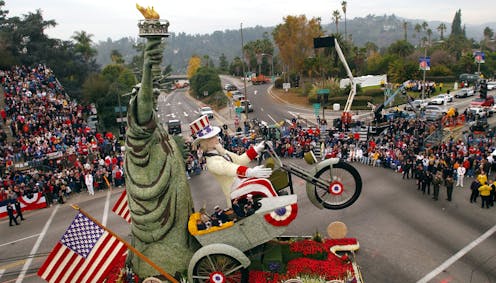How did Uncle Sam become a symbol for the United States?
- Written by Paul Bruski, Associate Professor of Graphic Design, Iowa State University

Uncle Sam isn’t the only symbol that U.S. artists and illustrators have used to convey political issues of the day.
One of the earliest symbolic stand-ins for the United States was “Columbia[12],” a female icon usually dressed in a toga.
In one famous depiction, she’s seen mourning President Abraham Lincoln, joined by Britannia[13], another female character who personifies England, and a formerly enslaved person whose plight remains unclear.
So where did Uncle Sam’s name come from? According to a resolution Congress approved in 1961[15], it originated with meat supplier Samuel Wilson of Troy, New York. During the War of 1812, he marked his materials for military use with “U.S.” Workers at the time would tell a joke along the lines that “Uncle Sam” Wilson was feeding the Army.
Perhaps not coincidentally, two African-American Marvel superheroes are named Sam Wilson: “The Falcon[16],” who goes on to become Captain America following Steve Rogers’ retirement, and Samantha Wilson, who assumed the role of Captain America in the recent Spider-Gwen series[17].
But there was another figure resembling Uncle Sam called Brother Jonathan[19] who emerged earlier.
That personification of the United States was possibly modeled on John Trumbull[20], a Colonial Connecticut governor who opposed British rule during the War of Independence. Brother Jonathan may have morphed into Uncle Sam[21] around the time of the Civil War, before fading away.
In an 1876 advertisement, this young, slender man who symbolized the nation wore clothing that echoes the American flag. He looked a lot like a younger and cleanshaven version of Uncle Sam.
It’s possible that the lankiness and facial features that Uncle Sam inherited from later depictions of Brother Jonathan were a tribute to President Abraham Lincoln[22].
Hello, curious kids! Do you have a question you’d like an expert to answer? Ask an adult to send your question to CuriousKidsUS@theconversation.com[23]. Please tell us your name, age and the city where you live.
And since curiosity has no age limit – adults, let us know what you’re wondering, too. We won’t be able to answer every question, but we will do our best.
References
- ^ Curious Kids (theconversation.com)
- ^ curiouskidsus@theconversation.com (theconversation.com)
- ^ Uncle Sam (www.history.com)
- ^ political cartoons (www.politico.com)
- ^ soccer games (www.atlutd.com)
- ^ political rallies (eduardobarraza.photoshelter.com)
- ^ Captain America (marvelcinematicuniverse.fandom.com)
- ^ Army recruiting poster (www.loc.gov)
- ^ James Montgomery Flagg (www.washingtonpost.com)
- ^ World War II (amhistory.si.edu)
- ^ Library of Congress (www.loc.gov)
- ^ Columbia (www.meetamerica.com)
- ^ Britannia (www.royalmint.com)
- ^ The Cartoon Collector/Print Collector via Getty Images (www.gettyimages.com)
- ^ resolution Congress approved in 1961 (www.history.com)
- ^ The Falcon (marvelcinematicuniverse.fandom.com)
- ^ Spider-Gwen series (www.marvel.com)
- ^ Kean Collection/Getty Images (www.gettyimages.com)
- ^ Brother Jonathan (www.atlasobscura.com)
- ^ John Trumbull (www.newenglandhistoricalsociety.com)
- ^ Brother Jonathan may have morphed into Uncle Sam (www.sonofthesouth.net)
- ^ President Abraham Lincoln (www.kshs.org)
- ^ CuriousKidsUS@theconversation.com (theconversation.com)
Read more https://theconversation.com/how-did-uncle-sam-become-a-symbol-for-the-united-states-171283

















